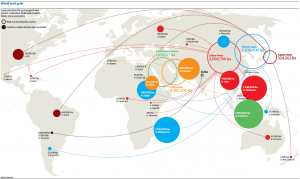The System of Rice Intensification (SRI) strikes again, now on Java and Bali:
Farmers across Indonesia have bumper rice harvests thanks to a revolutionary method: 50 percent increase in yield with just one 10th of the seed, virtually no chemical fertilizers and little water.
SRI is a system which consists of transplanting widely spaced very young individual rice plants, using organic fertilizers, and not permanently saturating the fields with water. The method was developed — on the basis of existing farmer practices — by a priest in Madagascar in the 1980s, and it has since found a prophet in Norman Uphoff. It is still used in Madagascar, but mainly by larger farmers, as it is too labor intensive for the smaller farmers (who do the work for the large farmers). Or so I was told when I visited there earlier this year.
The BBC reported a doubling of yields in Nepal. George Bush was briefed about it during his visit to India. Luigi wrote about it a year ago. And now the reports of bumper crops in Indonesia.
All is for the best then? Not really: the whole thing is rather controversial. Tom Sinclair said this about it in 2004:
SRI appears to be only the latest in a family of unconfirmed field observations (UFOs) (…). While there is an abundance of “sightings,” they are anecdotal and reported by people who have minimum understanding of the basic scientific principles being challenged by such reports. In many cases, mysterious circumstances are invoked to explain the miraculous.
In a rather thorough review, in 2006, McDonald, Hobbs and Riha found that it sometimes works (in Madagascar), but that generally yields are 11% lower with SRI, not higher.
What is one to think then? Do newspapers blindly follow NGOs, and do farmers say what is scripted? Another case of overselling? Or is this a true farmer/priest led breakthrough, which scientist at fancy universities and research institutes just do not get?
There certainly has been overselling, with claims of unrealistically high rice yields (e.g., 15 tons per hectare). However, there could be circumstances where SRI does have benefits, for example on some problem soils (with iron toxicity), and perhaps in other low potential situations as well.
When SRI ‘works’, it is hard to know what farmers really did. Perhaps planting density was not quite that low, and organic fertilizer were applied at very high. What is SRI being compared with anyway? A degenerate farm, or a fully optimized ‘modern’ farm?
More field trials are planned. I am not optimisitic, but let’s hope that they will provide some clarity about the conditions under which SRI increases yields (or not). The dispute would be settled, and we’d have more rice for less resources.
